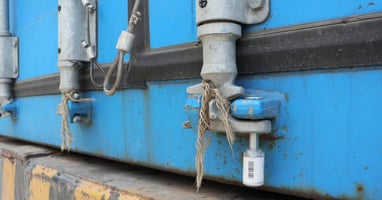Those who store or ship products understand the peace of mind that comes with knowing their goods...
What Is Security Seal Replication and How Do You Combat It?

Counterfeiters are becoming more sophisticated. As they’re learning how to replicate security seals, they’re posing significant risks to businesses and consumers worldwide.
The issue goes far beyond simple imitation; it’s a direct threat to product security and consumer confidence. Businesses need to understand the severity of security seal replication and how to combat it.
Examine the importance of security seals and the serious concern of counterfeiting. Learn innovative solutions to transform the fight against this problem as industries strive to stay ahead of those who seek to undermine them.
What Is Security Seal Replication?
Security seal replication refers to the process by which counterfeiters create unauthorized copies of security seals. These replicated seals mimic the design, materials, and functionalities of authentic seals, making it difficult to distinguish between genuine and counterfeit products. The goal of replication is to bypass security protocols and enable access to goods during transit or storage.
Modern security seals include unique features, like QR codes, to safeguard the integrity of transported goods. However, the growing sophistication of replication techniques threatens the efficacy of advanced security measures.
Understanding security seal replication is the first step in addressing this concern. By identifying vulnerabilities within current security protocols, businesses can implement more robust strategies to deter replications and maintain the integrity of their operations.
Why Is Security Seal Replication a Serious Problem?
Security seal replication has far-reaching consequences that impact not only individual businesses but also entire supply chains and industries. Health risks, economic losses, and a damaged reputation are the three key risks posed by counterfeit seals.
Health Risks
One of the most alarming consequences of security seal replication involves products that directly impact public health, such as pharmaceuticals and food items. Counterfeit seals can allow unauthorized tampering or substitution of genuine products, risking contamination or providing inferior, unsafe alternatives.
These risks are particularly dangerous in industries governed by stringent safety standards. A single breach can lead to wide-scale recalls, diminish public trust, and endanger lives.
Economic Losses
The replication of security seals commonly facilitates theft, smuggling, or fraudulent trading. All of these contribute to significant financial losses for businesses. The compromised integrity of transported goods can result in legal disputes, missed delivery obligations, and financial penalties.
Additionally, counterfeit seals can disrupt supply chain operations. This can and will lead to inefficiencies, revenue loss, and weakened business relationships.
Hinder a Business’s Reputation
Reputation is one of a company’s most valuable assets, and security seal replication can cause irreparable harm. If customers or stakeholders lose trust in a company’s ability to operate securely, the long-term consequences can include loss of clients, reduced market share, and limited access to future opportunities.
For businesses dealing in high-value or regulated goods, maintaining robust security measures is crucial to protecting their reputation.

Techniques Used by Counterfeiters To Replicate Security Seals
Now that you understand the dangers of replicated security seals, you must also be aware of the techniques employed by counterfeiters. This can help you effectively combat the use of these fake seals. While these methods vary in complexity, there are a few common approaches to understand.
Photocopying Holographic Designs
Advanced photocopying tools and printing equipment allow counterfeiters to replicate holographic designs employed on high-security seals. These designs, which are meant to provide visible evidence of tampering or duplication, can lose their effectiveness when replicated with precision.
Reproducing Serial Numbers or QR Codes
Many security seals feature unique serial numbers or QR codes to ensure traceability and authentication. Counterfeiters, however, can reproduce these codes, enabling them to create seemingly legitimate seals that evade standard verification processes.
Copying Tamper-Evident Materials and Finishes
Tamper-evident materials may include color-changing adhesives or breakable seals. Nevertheless, counterfeiters can copy these materials using advanced synthetic products that closely mimic the originals. By producing counterfeit seals with convincing tamper-evident features, counterfeiters make it difficult for supply chain professionals to identify unauthorized access.
How Can You Combat Security Seal Replication?
Preventing security seal replication requires a multi-faceted approach. By combining innovative technologies, frequent updates, and heightened awareness, businesses can stay ahead of counterfeiters. Here are five key strategies to consider:
Advanced Security Features
Investing in seals with state-of-the-art security features is one of the most effective ways to combat replication. Look for seals that incorporate cutting-edge elements such as:
- Microtext or nanotechnology that is impossible to replicate without specialized equipment.
- Unique tamper-evident finishes
- Multilayered holographic patterns.
Digital Verification Technologies
Digital verification technologies, including blockchain-backed QR codes and radio-frequency identification (RFID) tracking, allow businesses to verify seals in real time. These technologies enhance traceability. This guarantees that the system only recognizes genuine seals, like three-state truck seals, through the supply chain.
Regular Seal Redesign
Regularly updating the design of security seals makes replication more difficult for counterfeiters. Introducing new materials, designs, or authentication features keeps your business ahead of replication techniques. This is a great strategy to reduce the likelihood of successful counterfeit attempts.
Third-Party Authentication Services
Working with specialized third-party providers skilled in authentication technologies can strengthen the security process. These services can include forensic analysis of seals, monitoring technology for broad supply chain security, and certification of seal authenticity.
Training and Awareness
Educating supply chain personnel about the risks of security seal replication and how to identify potential counterfeits is critical. Conduct regular training sessions to raise awareness and establish clear protocols for inspecting and verifying seals throughout your supply chain.

Consider Logimate for Security Seals You Can Trust
Logimate provides a comprehensive range of high-quality security seals designed to meet diverse applications across numerous industries. With a focus on innovation and reliability, we can ensure that each seal delivers top-tier protection and enhances supply chain security. Choose Logimate for trusted solutions tailored to safeguard your operations.
Key Takeaways for Successful Freight Security
Security seal replication poses significant risks to industries, from economic losses to reputational damage and health hazards. By combining advanced security measures with cutting-edge technologies and training initiatives, businesses can protect their supply chains more effectively.
Learning how to combat security seal replication isn’t a single action but a dynamic, ongoing process. With the right tools and consistent vigilance, supply chain managers and security professionals can fortify operations against the risks of replication and ensure the integrity of their freight.
Take the time to evaluate your current security seal strategy and consider implementing some of the techniques outlined in this guide. The stronger your defenses, the more confident your customers and stakeholders will be in your ability to deliver safe, reliable service.




